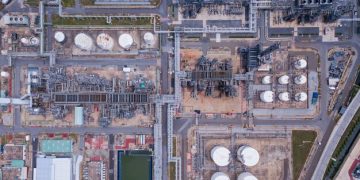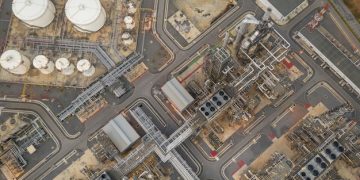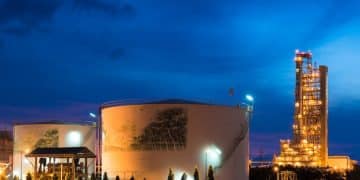Leveraging EPA Regulations: A Guide for US Businesses on Methane Reduction

US businesses can leverage the new EPA regulations for methane emissions reduction by investing in methane detection technologies, improving infrastructure to prevent leaks, capturing and utilizing methane, and adopting innovative operational practices to minimize emissions, ensuring compliance and fostering a sustainable future.
The Environmental Protection Agency (EPA) has recently introduced new regulations targeting methane emissions, presenting both challenges and opportunities for US businesses. Understanding how to navigate and capitalize on these regulations isn’t just about compliance; it’s about fostering innovation, improving efficiency, and contributing to a more sustainable future. Let’s explore how US businesses can leverage the new EPA regulations for methane emissions reduction.
Understanding the EPA’s Methane Regulations
The EPA’s new methane regulations aim to significantly reduce methane emissions from the oil and gas industry, a major contributor to greenhouse gases. These regulations target various aspects of operations, from leak detection and repair to equipment standards and reporting requirements. Understanding the scope and implications of these rules is the first step for businesses looking to comply and benefit.
These regulations are not merely a burden; they’re an incentive for innovation and efficiency. By proactively addressing methane emissions, companies can improve their operational practices, reduce waste, and even create new revenue streams.
Key Components of the EPA Methane Rules
The new EPA regulations cover a wide range of sources and activities within the oil and gas sector. Here are some of the key components:
- Leak Detection and Repair (LDAR): Requires companies to implement robust leak detection programs using advanced technologies like optical gas imaging (OGI) cameras and drones. Regular inspections and prompt repairs are essential.
- Equipment Standards: Sets standards for new and modified equipment, such as pneumatic controllers, storage tanks, and compressors, to minimize methane leaks.
- Reporting Requirements: Mandates detailed reporting of methane emissions, allowing the EPA to track progress and ensure compliance.
Staying informed about these components is crucial for developing effective compliance strategies and identifying opportunities for improvement.
In conclusion, understand the complexities of the EPA methane regulations is paramount for US businesses. By recognizing both the requirements and the potential benefits, companies can position themselves for success in a rapidly evolving regulatory landscape.
Investing in Methane Detection Technologies
One of the most effective ways for US businesses to comply with the EPA’s methane regulations is to invest in advanced methane detection technologies. These technologies enable companies to identify and quantify methane leaks quickly and accurately, allowing for timely repairs and preventing significant emissions.
Investing in these technologies not only ensures compliance but also enhances operational efficiency and reduces waste.

Types of Methane Detection Technologies
Several innovative technologies are available for methane detection, each with its own advantages and applications:
- Optical Gas Imaging (OGI) Cameras: These cameras use infrared technology to visualize methane leaks, making them visible to the naked eye. They are highly effective for quickly scanning large areas.
- Sensors and Drones: Methane sensors can be mounted on drones to survey remote or hard-to-reach areas, providing continuous monitoring and rapid detection of leaks.
- Satellite Monitoring: Satellites equipped with methane detection sensors can monitor large regions, identifying significant emission sources and helping companies pinpoint areas of concern.
Choosing the right technology depends on the specific needs and scale of the operation, but the investment is crucial for effective methane management.
By adopting these technologies, companies can significantly reduce their environmental impact and improve their bottom line.
Improving Infrastructure to Prevent Leaks
Upgrading and maintaining infrastructure is crucial for preventing methane leaks. Aging pipelines, faulty valves, and outdated equipment are common sources of emissions. By investing in infrastructure improvements, US businesses can minimize leaks and ensure compliance with EPA regulations.
Modernizing infrastructure not only reduces emissions but also improves the safety and reliability of operations.
Best Practices for Infrastructure Improvement
Here are some best practices for improving infrastructure to prevent methane leaks:
- Regular Inspections and Maintenance: Implement a rigorous inspection and maintenance program to identify and address potential leaks before they become significant issues.
- Pipeline Replacement: Replace old or corroded pipelines with modern, leak-resistant materials.
- Valve Upgrades: Upgrade faulty or outdated valves with new, high-performance valves designed to minimize leaks.
These measures can significantly reduce fugitive emissions and improve the overall efficiency of operations.
In conclusion, proactive infrastructure management is essential for preventing methane leaks. By adopting these practices, companies can reduce their environmental footprint and improve the long-term sustainability of their operations.

Capturing and Utilizing Methane
Instead of simply flaring or venting methane, US businesses can capture and utilize it as a valuable energy source. Capturing methane from sources like landfills, agricultural operations, and wastewater treatment plants can generate renewable energy, reduce emissions, and create new revenue streams.
This approach transforms a potential environmental liability into an economic asset.
Applications of Captured Methane
Captured methane can be used in a variety of ways:
- Electricity Generation: Methane can be used to fuel generators, producing electricity for on-site use or for sale to the grid.
- Direct Use as Fuel: Methane can be used as a direct fuel source for heating, cooking, and transportation.
- Production of Renewable Natural Gas (RNG): Methane can be upgraded to RNG, a pipeline-quality gas that can be used interchangeably with fossil natural gas.
Exploring these applications can help companies diversify their energy portfolio and reduce their reliance on fossil fuels.
In conclusion, capturing and utilizing methane is a win-win strategy for US businesses. It reduces emissions, generates clean energy, and creates new economic opportunities aligned with a more sustainable future.
Adopting Innovative Operational Practices
In addition to technological solutions, innovative operational practices can significantly reduce methane emissions. Simple changes in procedures and processes can lead to substantial reductions in fugitive emissions, helping US businesses comply with EPA regulations while improving efficiency.
These practices often require minimal investment but yield significant environmental and economic benefits.
Examples of Innovative Operational Practices
Here are some examples of operational practices that can reduce methane emissions:
- Reduced Emissions Completions (RECs): Using RECs during well completions to capture and sell or reinject natural gas that would otherwise be flared.
- Pneumatic Controller Optimization: Replacing high-emitting pneumatic controllers with low- or zero-emitting alternatives.
- Centralized Tank Systems: Consolidating storage tanks to reduce the number of potential leak sources and improve monitoring efficiency.
Exploring and implementing these practices positions companies as environmental stewards.
In conclusion, implementing operational adjustments is a vital component of methane mitigation. Businesses can demonstrate environmental responsibility and long-term operational sustainability by embracing these strategies.
Collaborating with Industry and Government Initiatives
Collaborating with industry and government initiatives can provide US businesses with access to resources, expertise, and funding opportunities for methane emissions reduction projects. Participating in these initiatives can help companies stay informed about best practices, share knowledge, and leverage financial incentives.
Collaboration fosters innovation and accelerates the adoption of methane mitigation technologies.
Benefits of Collaboration
Here are some of the benefits of collaborating with industry and government initiatives:
- Access to Funding: Many government and industry programs offer grants, tax credits, and other financial incentives for methane reduction projects.
- Knowledge Sharing: Collaboration provides opportunities to learn from peers, share experiences, and adopt best practices.
- Technical Assistance: Some initiatives offer technical assistance and training to help companies implement methane mitigation strategies.
Active engagement in these partnerships can pave the way for lasting environmental progress.
In conclusion, proactive engagement in industry and government projects strengthens US businesses. Businesses can access financing, share expertise, and promote methane abatement technologies by working together, leading to long-term operational resilience and environmental stewardship.
| Key Point | Brief Description |
|---|---|
| 🔎 Understand EPA Rules | Know the requirements and opportunities in the new methane regulations. |
| 📷 Invest in Detection | Use technologies like OGI cameras and drones for quick leak detection. |
| 🛠️ Improve Infrastructure | Upgrade old pipelines and valves to prevent methane leaks. |
| 💡 Capture & Utilize | Convert captured methane into electricity, fuel, or renewable natural gas. |
Frequently Asked Questions (FAQ)
▼
The primary goals are to significantly reduce methane emissions from the oil and gas industry, targeting leak detection, equipment standards, and reporting requirements to mitigate greenhouse gas emissions.
▼
OGI cameras use infrared technology to visualize methane leaks, making them visible to the naked eye, allowing for quick and efficient scanning of large areas to identify leaks.
▼
RECs are well completion practices designed to capture and sell or reinject natural gas that would otherwise be flared, reducing methane emissions during the completion process.
▼
Captured methane can be used for electricity generation, direct fuel use for heating and transportation, or upgraded to Renewable Natural Gas (RNG) for pipeline use, diversifying energy sources.
▼
Yes, many government and industry programs offer grants, tax credits, and other financial incentives for companies implementing methane reduction technologies and operational practices.
Conclusion
US businesses can turn the EPA’s new methane rules into opportunities for innovation and sustainability. By investing in methane detection technologies, improving infrastructure, capturing and utilizing methane, adopting innovative operational practices, and collaborating with industry and government initiatives, companies can not only comply with regulations but also enhance their operational efficiency and contribute to a cleaner, more sustainable future.





